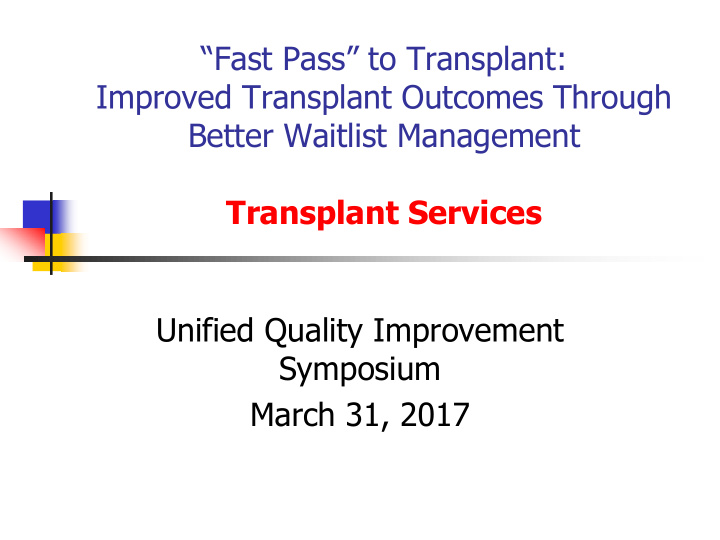



“Fast Pass” to Transplant: Improved Transplant Outcomes Through Better Waitlist Management Transplant Services Unified Quality Improvement Symposium March 31, 2017
Collaborative Team Members Project Leader(s) and Discipline: Koren Way – Transplant Administrator David Axelrod, MD, MBA – Division Chief Team Member Name(s) and Discipline: Janet Gooden, NP – Transplant Nurse Practitioner Cindy Stone, RN – Transplant Coordinator Clifton Hill, LCSW – Transplant Social Worker Karen Chamberlain, RN – Transplant Coordinator Erica Manley – Transplant Assistant
The Problem In short, there are more patients waiting for a transplant than there are organs available. As a result a sick population becomes even sicker while they wait. The median waiting time for a life saving kidney transplant is almost 4 years. In some regions the proportion of patients transplanted at 5 years still does not exceed 25%. During this time, 13 people a day, and almost 5,000 people a year will die while waiting. Another almost 4,000 will become too ill and will be removed from the waiting list.
What can be done about it? While it is a challenge for transplant centers to evaluate patients and add patients to the waiting list, it is becoming an even more difficult and increasingly important challenge to keep them well while on the waiting list Some transplant centers have chosen to reduce access to the waiting list and become more cautious Reduce listing higher risk patients Results in lower transplant volumes and reduced access to transplant for deserving and acceptable recipients. We believe a more effective strategy is active management of patients who are waiting on the list.
AIM Statement 1. To increase the percentage of patients on the kidney transplant waiting list who are in active status without decreasing the total number of patients on the waiting list. 2. Increase the number of transplants performed 3. Decrease a patient’s time waiting on the list and the number of patients who die without being transplanted.
Issues Identified by Program Leadership Insufficient staff and time dedicated to the management of waitlist patients. Lack of adequate and timely follow-up of waitlist patients Poor structure and processes to ensure patients were re-activated once medical and psychosocial issues were resolved Inadequate IT support to track patients
Improvement Strategies Employed Developed timely, consistent, and effective communication tools for patients and referring providers regarding status on the waiting list and outstanding issues. Developed and implemented standardized tracking tools in the EHR to ensure testing is completed while on the waiting list Real time tracking of waitlist metrics to provide immediate team feedback
Improvement Strategies Employed Redeployed staff to create a multidisciplinary waitlist team Includes RN coordinator, social worker, and transplant assistants Dedicated physician team to provide oversight and medical decision making Created weekly team meetings with a consistent agenda to review patients, Develop coordinated plans, and ensure follow up Team meetings include core team members, medical and surgical leadership, finance and division administration.
How Will We Know This Change Is An Improvement? Process Measure(s): Percent active/able to receive an organ on the waiting list by month Total number of patients on the waiting list per month Number of patients re-activated for transplant Outcome Measure(s): Total number of transplants per year Risk adjusted rate of transplant (SRTR risk adjustment) Risk adjusted waitlist mortality rate (SRTR risk adjustment)
Outcomes Active Patients on the Kidney Transplant Waiting List Over 7 months, the 85% proportion of patients who were active 65% increased 44% to 71%. The total number of patients who were 45% active on the list 135 to 172. 25%
Outcomes Increase in the volume of Number of Transplants transplants performed Performed 40 More patients were able to receive offers and so 30 more transplants could be done. Increase in transplant 20 revenue for Vidant. More transplants 10 yields better quality of life for patients 0 6 mos prior to 6 mos following intervention intervention
Outcomes The current mortality rate for our patients on the waiting list is significantly lower than would be expected for similar patients at another center. Improved access to transplant results in better survival and quality of life for patients with end stage renal disease
Outcomes Risk Adjusted Transplant Rate: The current rate of deceased Deceased Donor donor transplant for patients 18 on the waiting list is 16 statistically significantly faster 14 than would be expected for 12 similar patients at other transplant centers 10 8 Improved access for deceased donor transplant is vital as 6 access to living donor 4 transplant has been limited in 2 eastern NC 0 observed expected
Next Steps Improved patient education while on the waiting list through the use of hands on exercises and “homework assignments”. Improved education should reduce length of stay and readmission following transplant.
Recommend
More recommend